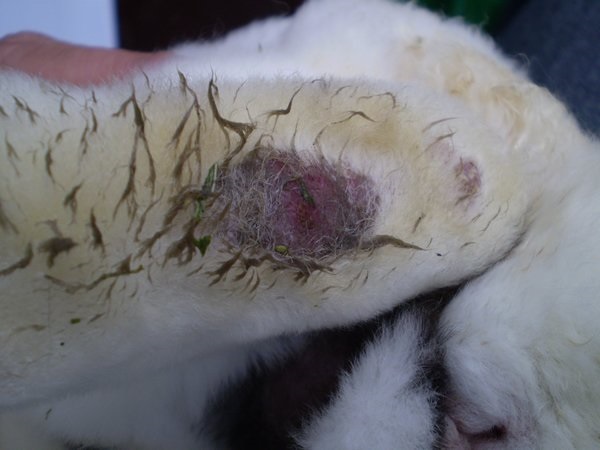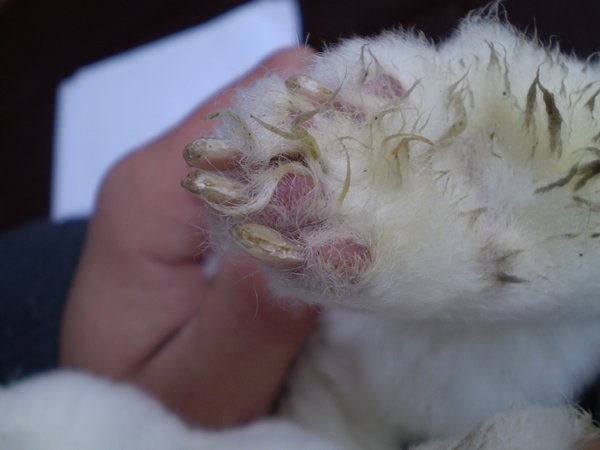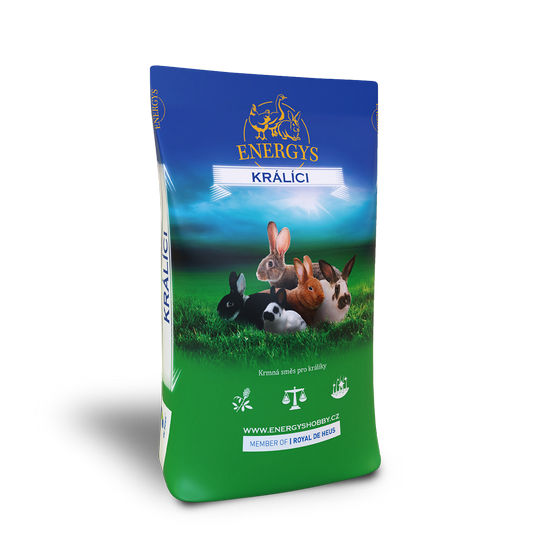Rabbits
Poultry
Laying hens
Quails
Guinea pigs
Pigs
Ostriches
Sheep and goats
Pigeons
Pheasants
Forest animals
Pressure sores on rabbit’s legs – an endless problem?
The contact surface on rabbits’ feet in hairy, which is rather unusual among mammals. Cases of the so-called pressure sores occurring on rabbits’ feet have been documented by breeders, especially those who breed rabbits for competitions. Pressure sores may disturb the animals’ movement and when left untreated may pose major health problems.
What does it look like?
Pressure sores on legs may appear at various intensity. At the first stage, they may not be clearly visible and may remain hidden under fur. This can be considered the critical stage, as these symptoms may escape the breeder’s attention. During the subsequent stage, the fur starts to thin and fall out, the skin hardens and reddens and the contact surfaces of feet become painful. During advanced stages of the disease, rabbits often do not move much. While hind legs are affected more frequently, affected front legs are not an exceptional occurrence, especially recently.


The development of the so-called chronic pododermatitis may be influenced by many genetic and external factors that must be considered in the treatment of pressure sores. The most important factors include:
- Breed
Especially heavier rabbit breeds are more susceptible to pressure sore symptoms. This also affects short-hair (rex) breeds. Solid, rather than grid floor is recommended for these breeds for this reason.
- Condition of animals
Pressure sores are detected more frequently in obese rabbits with unsuitable composition of the feeding dose or an inadequate feeding technique (overfeeding).
- Age of animals
Pressure sores are observed in practice in particular in adult and older rabbits. Cases of clinical symptoms in immature animals are rare.
- Technological character of floors
The occurrence of pressure sores is traditional attributed to the technological floor design, with grid floors being considered unsuitable in this regard. However, this may not apply in all cases. Grid floors undoubtedly ensure a higher standard of hygiene. Grids may be made of various materials – mostly metal or plastics. The quality (hardness) and shape (surface) of the material plays a major role especially in plastic grids, also with regard to potential undesirable chewing by rabbits. Installation of a protective plastic underlay is recommended in the case of metal grids to cover the metal wires and eliminate or reduce the occurrence of pressure sores.
- Moisture content and temperature of substrate
Undesirable increased moisture and temperature of the bedding material significantly increases the risk of pressure sores occurring and the risk of their secondary infection. Cleaning pens more frequently is advised especially during summer months to ensure relatively dry bedding material for rabbits.
- Condition of claws
The length and the condition of claws is a relatively infrequently discussed topic that influences the occurrence of pressure sores. Uncut, long claws misshapen rabbit’s toes. Weight is then distributed incorrectly on legs, leading to painful walking (especially in the case of obese animals) and an increased risk of pressure sores occurring or modulating.
- Individual traits of animals
An animal’s individual traits may also be considered a major aspect. Several cases have been observed in practice, where several rabbits – siblings from a single litter exhibited symptoms of pressure sores despite being kept in the same technological system with similar feeding.
Therefore, not only bedding and feeding, but also consistent selection of animals to be used for breeding is important in this regard.
Related posts
10. April 2024
Keeping dwarf rabbits as pets is becoming increasingly popular. It does not require a lot of space and is ideal for people who live in smaller homes or apartments. Dwarf rabbits are also very friendly, so it’s no wonder that people are choosing them for this purpose more and more often. As with all animals,…
30. August 2022
In this article we will discuss several rabbit diseases – ear scab, tyzzer’s disease and heat stress.
24. August 2022
In this article we look at two diseases – e.Coli and enterocolitis.
2. August 2022
In this article we look at two common rabbit diseases, myxomatosis and infectious rhinitis.
13. July 2022
In the following article we will discuss rabbit plague – rhd or vhd (viral haemorrhagic disease of rabbits).
Related products

RABBIT DWARF
Complete pelleted feed for dwarf rabbits with high digestibility. It contains a high proportion of fibre (high alfalfa and grass cake content) and a reduced sugar and starch content. Contains flaxseed, which has a positive effect on coat quality. Suitable for daily feeding. We recommend providing rabbits with safe fresh water and hay.

RABBIT CHAMPION
Feed for show rabbits, does not include Coccidiostat. A unique mix significantly supports the quality and growth of fur. Serve when moulting and at least two months before the start of the show season.

RABBIT GOLD FORTE
A premium feed mix in an ideal make up for gestating and breast feeding females. For the intensive fattening of rabbits for a period of up to 5 days before slaughter. It supports fast growth, meat content and an excellent state of health. It contains a coccidiostat which lowers the risk of mortality.

RABBIT KLASIK FORTE
Intended for the fattening of rabbits up to a point at least 5 days before slaughter. Suitable for attaining a high meat content and an excellent state of health. Thanks to its Coccidiostat content it lowers the animals mortality.

RABBIT KLASIK
For the final phase of rabbit fattening, a minimum of 5 days before slaughter. It supports high meat content and excellent taste qualities in rabbit meat. Without a coccidiostat.

RABBIT START
For young rabbits from the start of accepting feed to 4-6 weeks after weaning. The feed helps to significantly lower the death rate in the period around weaning. It contains a raised percentage of fibre and less starch. It does not contain a coccidiostat.
